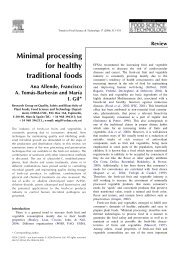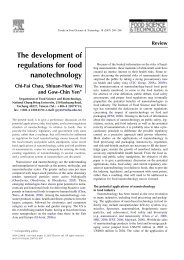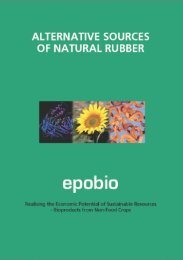production of wax esters in crambe
production of wax esters in crambe
production of wax esters in crambe
You also want an ePaper? Increase the reach of your titles
YUMPU automatically turns print PDFs into web optimized ePapers that Google loves.
time <strong>in</strong>creas<strong>in</strong>g the volume <strong>of</strong> <strong>production</strong>, these types <strong>of</strong> <strong>wax</strong> <strong>esters</strong> could<br />
immediately be considered for much larger market<strong>in</strong>g applications such as<br />
automotive, transmission and hydraulic fluids.<br />
Addition <strong>of</strong> jojoba oil (15-20%) to soybean oil has shown to effectively improve<br />
oxidation stability <strong>of</strong> the plant oil (Torres et al., 2006). However, due to a high price<br />
on <strong>wax</strong> <strong>esters</strong> from jojoba the f<strong>in</strong>al price on the improved soy oil will not compete<br />
with petroleum-based oils and would have difficulty to compete with synthetic oils as<br />
well.<br />
Hence, an alternative <strong>production</strong> <strong>of</strong> <strong>wax</strong> <strong>esters</strong> <strong>in</strong> a high-yield<strong>in</strong>g oil crop constitutes<br />
an attractive approach to provide the market with outstand<strong>in</strong>g lubrication oil at an<br />
affordable price level.<br />
Target genes to modify and redirect the flow <strong>of</strong> carbon cha<strong>in</strong> <strong>in</strong> the genetically<br />
modified Crambe to produce novel <strong>wax</strong> <strong>esters</strong> <strong>in</strong>clude:<br />
For a jojoba type <strong>of</strong> <strong>wax</strong> ester<br />
• Fatty acid reductase (FAR) with specificity towards C22:1. Crambe already<br />
has high levels <strong>of</strong> up to 60% <strong>of</strong> the long cha<strong>in</strong> erucic fatty acid (22:1).<br />
Consequently this fatty acid is a good substrate for the alcohol-produc<strong>in</strong>g<br />
FAR enzyme.<br />
• Acyl-CoA:fatty alcohol acyltransferase (WS) with specificity towards 22:1<br />
alcohol and C18 or C20 fatty acyl-CoA substrates. The 22:1 alcohol is used<br />
by WS for <strong>production</strong> <strong>of</strong> <strong>wax</strong> <strong>esters</strong> with a C18 or a C20 fatty acid. The<br />
desired <strong>wax</strong> product would have a structure <strong>of</strong> C 40-44 consist<strong>in</strong>g <strong>of</strong> a long<br />
cha<strong>in</strong> fatty alcohol C 20-22 esterified to a long cha<strong>in</strong> fatty acid C 18-22 and conta<strong>in</strong><br />
not more than 1 double bond per carbon cha<strong>in</strong>.<br />
35









